

Conference magazine. Ripping Learning off the Page. Virtual reality is a powerful, low-cost, easy-to-access resource for teachers.
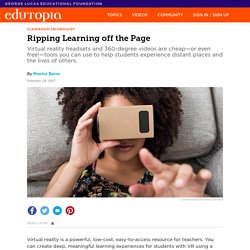
You can create deep, meaningful learning experiences for students with VR using a headset like the inexpensive Google Cardboard. With this device and a smartphone, students can be transported instantly to different places around the world. If using headsets and smartphones isn’t the best fit for your class, there are many 360-degree video experiences viewable on iPads and Chromebooks that provide a VR-like experience. As a former one-to-one iPad teacher and big fan of scannable technology, I’m excited by the potential of virtual reality to support reading instruction. Virtual reality has the capacity to capture the attention of our students, and we can use this technology to elevate traditional learning experiences that connect to learning goals.
MIL as Composite Concept. Empowerment of people through Media and Information Literacy (MIL) is an important prerequisite for fostering equitable access to information and knowledge and promoting free, independent and pluralistic media and information systems.
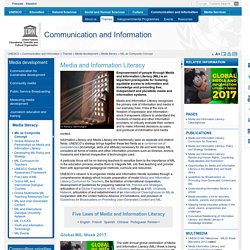
Media and Information Literacy recognizes the primary role of information and media in our everyday lives. It lies at the core of freedom of expression and information - since it empowers citizens to understand the functions of media and other information providers, to critically evaluate their content, and to make informed decisions as users and producer of information and media content. Information Literacy and Media Literacy are traditionally seen as separate and distinct fields. UNESCO’s strategy brings together these two fields as a combined set of competencies (knowledge, skills and attitude) necessary for life and work today.
Blended learning: what’s in it for the learner? A Digifest debate. Blended learning is a buzzword in teaching, but what does it really mean for the learner?
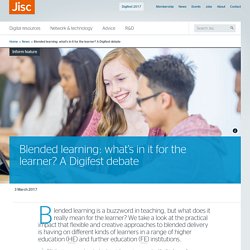
We take a look at the practical impact that flexible and creative approaches to blended delivery is having on different kinds of learners in a range of higher education (HE) and further education (FE) institutions. “We live in an age where technology is becoming everyday life. What's on the Horizon (Still, Again, Always) for Ed-Tech. 3 min read The New Media Consortium and the EDUCAUSE Learning Initiative have released the latest NMC Horizon Report for Higher Education.
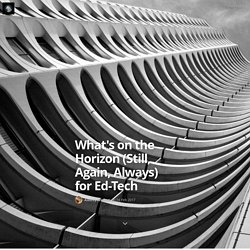
I have written quite a bit about the problems (as I see them) with the Horizon Report, most recently in a talk I gave last fall at VCU: “The Best Way to Predict the Future is to Issue a Press Release.” I have taken issue with the NMC’s refusal to revisit previous years’ predictions, for example, which is why I started a project where you can see at a glance how the predictions have and have not changed over the decade-plus of the Horizon Report’s existence. Taxonomy Of eLearning: Does eLearning Need A New Taxonomy? - eLearning Industry. When we think about eLearning and taxonomy we often think of Benjamin Bloom’s well-known taxonomy of educational objectives (created in 1956), which is easily understood and is probably the most widely applied today, serving as the backbone of many teaching philosophies.
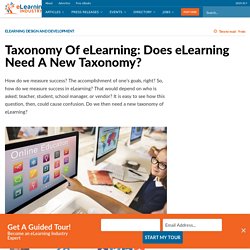
Bloom's taxonomy is most often used when designing educational, training, and learning processes; particularly when wanting to promote higher forms of thinking in education, such as analyzing and evaluating concepts, processes, procedures, and principles, rather than just remembering facts (rote learning, etc.). Bloom identified 3 ‘domains’ of educational activities or learning: Cognitive.Mental skills (knowledge).Affective.Growth in feelings or emotional areas (attitude or self).Psychomotor. Manual or physical skills (skills). What Makes a Successful Online Student? Like the facilitator, the online student possesses unique qualities.
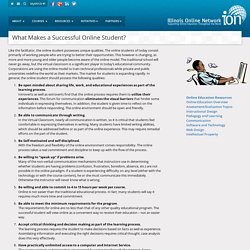
The online students of today consist primarily of working people who are trying to better their opportunities. This however is changing, as more and more young and older people become aware of the online model. The traditional school will never go away, but the virtual classroom is a significant player in today’s educational community. Three Strategies to Power Your Self-Directed Learning. The most important skill for a young person today is learning quickly and effectively.
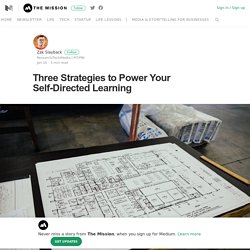
Since the Great Recession, nobody buys the false impression that you can get a credential after studying for four years, land a job, and then have a career with the same core set of skills over your entire life. Even professional career tracks like medicine and law are under outside economic and technological pressure to change and adapt at a faster pace than ever before. The idea of school and college teaching you the skills you need to succeed is so laughable today that it is considered a joke among employers. Demand for Digital Courseware Is Higher Than Supply, Survey Says. Now, more than ever, higher education stakeholders believe digital course materials are the key to solving systemwide problems.
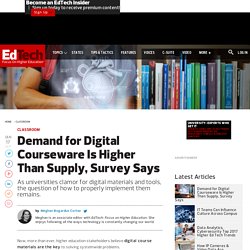
A recent Pearson Education survey called “Digital appetite vs. what’s on the table,” found that at least 84 percent of students, teachers and administrators said a shift to digital could help with challenges they face. About 82 percent of those surveyed also said that digital is the future, but only 56 percent said more than half of their institution’s courses are using some sort of digital courseware. “In this gap, we see a clear and vast opportunity to transform the classrooms of today, for educators to be key allies in advancing teaching and learning through innovative and research-driven technology, and to ensure that their technology experience in education matches the digital reality that today’s students are embracing in their day-to-day lives,” reads the survey.
The demand may be there, but what about the devices required to go digital? Modern educational process undergoes regular changes and one of the main reasons of that is technological development.
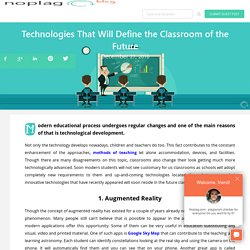
Not only the technology develops nowadays, children and teachers do too. This fact contributes to the constant enhancement of the approaches, methods of teaching let alone accommodation, devices, and facilities. How Well are we Preparing Students for the Future of Work? As a former history teacher, it makes me laugh and cry that so many prominent figures in education (especially education technology) have such a poor understanding of the history of their subject.
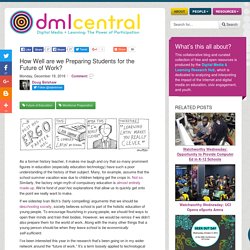
Many, for example, assume that the school summer vacation was due to children helping get the crops in. Not so. Eight inspirational learning spaces - from Digifest speaker, Andrew Harrison. The following learning spaces are not necessarily spectacular pieces of architecture destined for awards but what they represent to me are a series of spaces that interest and intrigue me, that point to thinking about learning spaces in a different way – blurring the boundaries between learning, working and living to meet the diverse needs of learners. Kiva, Institute for Educational Development, Aga Khan University, Karachi, Pakistan The Kiva is a learning space that is based on the kivas of the puebloans of the American south west but has been transplanted to a postgraduate education institute in Karachi to create a democratic space to celebrate story telling and discussion.
Technology has deliberately been pushed to the edge of the room and the space design and pedagogy are completely integrated. University of Melbourne Learning Lab, Melbourne, Australia. The death of the digital native: four provocations from Digifest speaker, Dr Donna Lanclos. In these four provocations, anthropologist Donna Lanclos argues that the notion of the "digital native" is bogus and disempowering, that pandering to student expectations can backfire, universities should be open by default, and our attitude to educational technology needs a rethink.
Provocation one: The death of the digital native The 'digital native' is a generational metaphor. It's a linguistic metaphor. It's a ridiculous metaphor. 2016 Student and Technology Research Study Infographic. Educational Technology Infographics Higher Education Infographics Student Infographics Undergraduate School Infographics 2016 Student and Technology Research Study Infographic 2016 Student and Technology Research Study Infographic EDUCAUSE Center for Analysis and Research (ECAR) collaborated with 183 institutions to collect responses from 71,641 undergraduate students across 25 countries about their technology experiences.
Future of work — Part 1 – The Startup – Medium. Background Automation. Disruption. Employee satisfaction. These are the few key words that are typically associated with the current generation and the way things work. Skills for Success in a Disruptive World of Work – Work Futures. In past decade or two, we have seen so many large businesses being disrupted or transformed completely by digital forces. This continues and accelerates as we go into the future that is driven by rise in automation. Experts predict that we are heading towards a “jobless future” and that it is both an opportunity and a threat. Future perfect: what will universities look like in 2030? Learning with 'e's: Digital literacies in the age of remix. Russell Stannard: Why are digital literacies so important? - Teacher´s Corner.
Allaboardhe. 55 Percent of Faculty Are Flipping the Classroom. Open Educational Thinkering. Web Literacy - Mozilla Learning. Web Literacy badges in GitHub. LinkedIn doubles down on education with LinkedIn Learning, updates desktop site. Author discusses new book, 'The Uberfication of the University' MOOCs take their place in the corporate learning world. Education Experts Discuss the Core Content Areas in Perfect Schools. Can We Think Critically Anymore? Digital literacy demands rethinking of necessary skills. The gig economy is making waves in education. 270. 270. New ISTE Standard For Students 2016. ISTE 2016: 5 Tech Trends Reshaping Education.
Why learning, adaptability will matter in the future workplace. Artificial intelligence and education. 3 key trends to shape the future of higher ed. Laptops, classrooms, and matters of electrate concern. Lesson Materials. Is virtual reality poised to transform higher ed? The challenges of teaching in a continuously developing world. Connected Learning. Top Ed-Tech Trends of 2015. Commonwealth Certificate for Teacher ICT Integration. 9780262527743 (2) Connected Learning report. Paper Calls for New Higher Education Credentialing System. Recognizing Online Degree Programs Across State Lines: Taking a More Uniform Approach. The digital language divide. European Schoolnet. Howard Rheingold. Schools of the future.
Teachers know best. It's not chalk and talk any more. Modern Learners - Bruce Dixon and Will Richardson. JISC Digital Literacy Workshop materials. Developing digital literacies. Developing digital literacies. Opening up education through innovation.